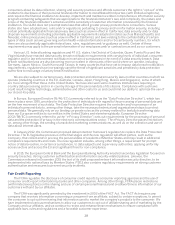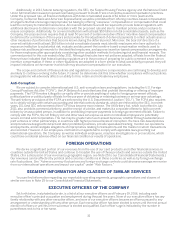American Express 2015 Annual Report Download - page 33
Download and view the complete annual report
Please find page 33 of the 2015 American Express annual report below. You can navigate through the pages in the report by either clicking on the pages listed below, or by using the keyword search tool below to find specific information within the annual report.
Source of Strength
A bank holding company is required by statute to act as a source of strength to all of its insured depository
institution subsidiaries. Therefore, the Company is required to act as a source of strength to Centurion Bank and
American Express Bank and may be required to commit capital and financial resources to support both institutions.
Such support may be required at times when, absent this requirement, the Company otherwise might determine not
to provide it.
Capital loans by a bank holding company to any of its subsidiary banks are subordinate in right of payment to
deposits and to certain other indebtedness of such subsidiary banks. In the event of a bank holding company’s
bankruptcy, any commitment by the bank holding company to a federal banking regulator to maintain the capital of a
subsidiary bank will be assumed by the bankruptcy trustee and entitled to a priority of payment.
Heightened Prudential Requirements for Large Bank Holding Companies
Dodd-Frank imposes heightened prudential requirements on bank holding companies with at least $50 billion in
total consolidated assets, including the Company, and requires the Federal Reserve to establish prudential standards
for such large bank holding companies that are more stringent than those applicable to other bank holding companies.
The Federal Reserve’s final rule implementing certain enhanced prudential requirements, including enhanced liquidity
and overall risk management, became effective on January 1, 2015. The Federal Reserve has not yet finalized rules for
two heightened prudential requirements mandated by Dodd-Frank — namely, bank holding company-consolidated
limits on exposures to single counterparties and early remediation requirements for large bank holding companies
experiencing financial distress. Apart from Dodd-Frank’s requirements, the Federal Reserve has discretionary
authority to establish additional prudential standards on its own, or at the recommendation of the Financial Stability
Oversight Council.
Stress Testing
As part of its implementation of the enhanced prudential requirements of Dodd-Frank, the Federal Reserve issued
rules relating to annual supervisory and semiannual company-run analyses of certain large bank holding companies, such
as the Company, to evaluate whether the companies have sufficient capital on a total consolidated basis to absorb losses
and support operations under adverse economic conditions (so-called “stress tests”). The Federal Reserve applies its
stress test rules and its capital planning requirements, discussed in “Capital Planning,” on a consolidated basis.
The FDIC and the OCC have also issued rules consistent with the Federal Reserve’s regulations governing
company-conducted stress testing to implement annual company stress testing requirements applicable to certain
banking organizations, including Centurion Bank and American Express Bank.
Centurion Bank and American Express Bank began reporting the results of their stress tests in 2015 and we publish
the stress test results for the Company, Centurion Bank and American Express Bank on our Investor Relations website.
Capital Planning
Bank holding companies with $50 billion or more in total consolidated assets, including the Company, are
required to develop and maintain a capital plan, and to submit the capital plan to the Federal Reserve for review under
its Comprehensive Capital Analysis and Review (“CCAR”) process. CCAR is designed to evaluate the capital adequacy,
capital adequacy process and planned capital distributions, such as dividend payments and common stock
repurchases, of a bank holding company subject to CCAR. As part of CCAR, the Federal Reserve evaluates whether a
bank holding company has sufficient capital to continue operations under various scenarios of economic and financial
market stress (developed by both the bank holding company and the Federal Reserve, including “adverse” and
“severely adverse” stress scenarios developed by the Federal Reserve). The scenarios are designed to stress our risks
and vulnerabilities and assess our pro-forma capital position and ratios under hypothetical stressed environments.
The Federal Reserve will also evaluate whether the bank holding company has robust, forward-looking capital planning
processes that account for its unique risks.
The capital plan must cover a “planning horizon” of at least nine quarters (beginning with the quarter preceding
the submission of the plan). The Federal Reserve has broad authority to object to capital plans, and to require bank
holding companies to revise and resubmit their capital plans. Bank holding companies are also subject to an ongoing
requirement to revise and resubmit their capital plans upon the occurrence of certain events specified by rule, or when
required by the Federal Reserve. In addition to other limitations, our ability to make any capital distributions (including
dividends and share repurchases) is contingent on the Federal Reserve’s non-objection to our capital plan under both
quantitative and qualitative tests. Should the Federal Reserve object to a capital plan, a bank holding company may not
make any capital distribution other than those capital distributions to which the Federal Reserve has indicated its non-
objection in writing. Beginning in 2016, participating bank holding companies are required to submit their capital plans
and stress testing results to the Federal Reserve on or before April 5 of each year, instead of on or before January 5 of
each year as previously required.
22
























